Nitazoxanide: A Drug Repositioning Compound with Potential Use in Chagas Disease in a Murine Model
Abstract
1. Introduction
2. Results
2.1. Parasitaemia, Body Condition and Survival
2.2. Antibody Quantification
2.2.1. Total IgG
2.2.2. IgG1
2.2.3. IgG2a
2.3. Serum Cytokine Levels
2.4. Organ Indices to Determine Cardiomegaly, Esplenomegaly and Lymphadenopathy
2.5. Histological Findings and Severity of Inflammation
3. Discussion
4. Materials and Methods
4.1. Model Animal
4.2. Infection, Parasitaemia and Survival
4.3. Nitazoxanide and Benznidazole Treatment
4.4. Serum Sample Collection
4.5. Antibody Quantification
4.6. Serum Cytokine Quantification
4.7. Determination of Visceral Megas
4.8. Histology
4.9. Statistical Analysis
5. Conclusions
Author Contributions
Funding
Institutional Review Board Statement
Informed Consent Statement
Data Availability Statement
Acknowledgments
Conflicts of Interest
References
- Diaz-Hernandez, A.; Gonzalez-Vazquez, M.A.; Arce-Fonseca, M.; Rodriguez-Morales, O.; Cedillo-Ramirez, M.L.; Carabarin-Lima, A. Risk of COVID-19 in Chagas Disease Patients: What Happen with Cardiac Affectations? Biology 2021, 10, 411. [Google Scholar] [CrossRef]
- PAHO Pan-American Health Organization. Chagas Disease Worksheet [Internet]. 2017. Available online: http://www.paho.org/chagasdisease (accessed on 16 December 2021).
- Balouz, V.; Agüero, F.; Buscaglia, C.A. Chagas disease diagnostic applications: Present knowledge and future steps. Adv. Parasitol. 2017, 97, 1–45. [Google Scholar] [PubMed]
- Arce-Fonseca, M.; Carrillo-Sánchez, S.C.; Molina-Barrios, R.; Martínez-Cruz, M.; Cedillo-Cobián, J.R.; Henao-Díaz, Y.A.; Rodríguez-Morales, O. Seropositivity for Trypanosoma cruzi in domestic dogs from Sonora, Mexico. Infect. Dis. Poverty 2017, 6, 120. [Google Scholar] [CrossRef] [PubMed]
- Muratore, C.A.; Baranchuk, A. Current and emerging therapeutic options for the treatment of chronic chagasic cardiomyopathy. Vasc. Health Risk Manag. 2010, 6, 593–601. [Google Scholar] [CrossRef] [PubMed]
- Machado, F.S.; Jelicks, L.A.; Kirchoff, L.V.; Shirani, J.; Nagajyothi, F.; Mukherjee, S.; Nelson, R.; Coyle, C.M.; Spray, D.C.; de Carvalho, A.C.C.; et al. Chagas Heart Disease Report on Recent Developments. Cardiol. Rev. 2012, 20, 53–65. [Google Scholar] [CrossRef]
- Manne, J.M.; Snively, C.S.; Ramsey, J.M.; Salgado, M.O.; Bärnighausen, T.; Reich, M.R. Barriers to treatment access for Chagas disease in Mexico. PLoS Negl. Trop. Dis. 2013, 7, e2488. [Google Scholar] [CrossRef]
- Bern, C. Chagas’ Disease. N. Engl. J. Med. 2015, 373, 456–466. [Google Scholar] [CrossRef]
- Adasme, M.F.; Bolz, S.N.; Adelmann, L.; Salentin, S.; Haupt, V.J.; Moreno-Rodríguez, A.; Nogueda-Torres, B.; Castillo-Campos, V.; Yepez-Mulia, L.; De Fuentes-Vicente, J.A.; et al. Repositioned Drugs for Chagas Disease Unveiled via Structure-Based Drug Repositioning. Int. J. Mol. Sci. 2020, 21, 8809. [Google Scholar] [CrossRef]
- Chan-Bacab, M.J.; Hernández-Núñez, E.; Navarrete-Vázquez, G. Nitazoxanide, tizoxanide and a new analogue [4-nitro-N-(5-nitro-1,3-thiazol-2-yl)benzamide; NTB] inhibit the growth of kinetoplastid parasites (Trypanosoma cruzi and Leishmania mexicana) in vitro. J. Antimicrob. Chemother. 2009, 63, 1292–1293. [Google Scholar] [CrossRef]
- Navarrete-Vazquez, G.; Chávez-Silva, F.; Argotte-Ramos, R.; Rodríguez-Gutiérrez, M.D.C.; Chan-Bacab, M.J.; Cedillo-Rivera, R.; Moo-Puc, R.; Hernández-Nuñez, E. Synthesis of benzologues of Nitazoxanide and Tizoxanide: A comparative study of their in vitro broad-spectrum antiprotozoal activity. Bioorg. Med. Chem. Lett. 2011, 21, 3168–3171. [Google Scholar] [CrossRef]
- Somvanshi, V.S.; Ellis, B.L.; Hu, Y.; Aroian, R.V. Nitazoxanide: Nematicidal mode of action and drug combination studies. Mol. Biochem. Parasitol. 2014, 193, 1–8. [Google Scholar] [CrossRef] [PubMed]
- Fox, L.M.; Saravolatz, L.D. Nitazoxanide: A new thiazolide antiparasitic agent. Clin. Infect. Dis. 2005, 40, 1173–1180. [Google Scholar] [CrossRef] [PubMed]
- Hoffman, P.S.; Sisson, G.; Croxen, M.A.; Welch, K.; Harman, W.D.; Cremades, N.; Morash, M.G. Antiparasitic drug nitazoxanide inhibits the pyruvate oxidoreductases of Helicobacter pylori, selected anaerobic bacteria and parasites, and Campylobacter jejuni. Antimicrob. Agents Chemother. 2007, 51, 868–876. [Google Scholar] [CrossRef]
- Valle-Reyes, J.S.; Melnikov, V.; Dobrovinskaya, O.; Rodriguez-Hernández, A.; Wookee-Zea, C.; Pimientel-Rodrigez, V.; Rueda-Valdovinos, G.; Delgado-Enciso, I.; López-Lemus, U.A.; Espinoza-Gómez, F. Antiprotozoal drug nitazoxanide enhances parasitemia, tissue lesions and mortality caused by Trypanosoma cruzi in murine model. Exp. Parasitol. 2017, 172, 44–50. [Google Scholar] [CrossRef] [PubMed]
- Rodríguez-Morales, O.; Cabrera-Mata, J.J.; Carrillo-Sánchez, S.D.C.; Gutiérrez-Ocejo, R.A.; Baylón-Pacheco, L.; Pérez-Reyes, O.L.; Rosales-Encina, J.L.; Aranda-Fraustro, A.; Hernández-García, S.; Arce-Fonseca, M. Electrolyzed Oxidizing Water Modulates the Immune Response in BALB/c Mice Experimentally Infected with Trypanosoma cruzi. Pathogens 2020, 9, 974. [Google Scholar] [CrossRef] [PubMed]
- De Fuentes-Vicente, J.A.; Vidal-López, D.G.; Flores-Villegas, A.L.; Moreno-Rodríguez, A.; De Alba-Alvarado, M.C.; Salazar-Schettino, P.M.; Rodríguez-López, M.H.; Gutiérrez-Cabrera, A.E. Trypanosoma cruzi: A review of biological and methodological factors in Mexican strains. Acta Trop. 2019, 195, 51–57. [Google Scholar] [CrossRef]
- Herreros-Cabello, A.; Callejas-Hernández, F.; Fresno, M.; Gironès, N. Comparative proteomic analysis of trypomastigotes from Trypanosoma cruzi strains with different pathogenicity. Infect. Genet. Evol. 2019, 76, 104041. [Google Scholar] [CrossRef]
- Arroyo-Olarte, R.D.; Martínez, I.; Lujan, E.; Mendlovic, F.; Dinkova, T.; Espinoza, B. Differential gene expression of virulence factors modulates infectivity of TcI Trypanosoma cruzi strains. Parasitol. Res. 2020, 119, 3803–3815. [Google Scholar] [CrossRef]
- Palma-González, C.A.; Recinos-Vázquez, H.I.; Burguete-Gutiérrez, J.C.; De Fuentes-Vicente, J.A.; Schlie-Guzmán, M.A.; Vidal-López, D.G.; Díaz-Gómez, J.; Vidal, J.E.; Gutiérrez-Jiménez, J. A Trypanosoma cruzi strain from southern Mexico is more virulent for male mice in part by blocking the immune response. J. Infect. Dev. Ctries. 2021, 15, 1714–1723. [Google Scholar] [CrossRef]
- Queiroga, T.B.D.; Pereira, N.S.; da Silva, D.D.; Andrade, C.M.; de Araújo Júnior, R.F.; Brito, C.R.D.N.; Galvão, L.M.D.C.; da Câmara, A.C.J.; Nascimento, M.S.L.; Guedes, P.M.M. Virulence of Trypanosoma cruzi Strains Is Related to the Differential Expression of Innate Immune Receptors in the Heart. Front. Cell. Infect. Microbiol. 2021, 11, 696719. [Google Scholar] [CrossRef]
- Strauss, M.; Rodrigues, J.H.S.; Presti, M.S.L.; Bazán, P.C.; Báez, A.L.; Paglini-Oliva, P.; Nakamura, C.V.; Bustamante, J.M.; Rivarola, H.W. In vitro and in vivo drug combination for the treatment of Trypanosoma cruzi infection: A multivariate approach. Exp. Parasitol. 2018, 189, 19–27. [Google Scholar] [CrossRef] [PubMed]
- Gulin, J.E.N.; Eagleson, M.A.; López-Muñoz, R.A.; Solana, M.E.; Altcheh, J.; García-Bournissen, F. In vitro and in vivo activity of voriconazole and benznidazole combination on Trypanosoma cruzi infection models. Acta Trop. 2020, 211, 105606. [Google Scholar] [CrossRef] [PubMed]
- Guedes-Da-Silva, F.H.; Batista, D.G.J.; Da Silva, C.F.; De Araújo, J.S.; Pavão, B.P.; Simões-Silva, M.R.; Batista, M.M.; Demarque, K.C.; Moreira, O.C.; Britto, C.; et al. Antitrypanosomal Activity of Sterol 14α-Demethylase (CYP51) Inhibitors VNI and VFV in the Swiss Mouse Models of Chagas Disease Induced by the Trypanosoma cruzi Y Strain. Antimicrob. Agents Chemother. 2017, 61, e02098-16. [Google Scholar] [CrossRef]
- Melnikov, V.; Espinoza-Gomez, F.; Newton-Sanchez, O.A.; Delgado-Ensiso, I.; Montesinos-Lopez, O.A.; Dalin, M.V.; Espinoza, B.; Martinez, I.; Sheklakova, L.A.; Dobrovinskaya, O.; et al. Integral approach to evaluation of the pathogenic activity of Trypanosoma cruzi clones as exemplified by the Mexican strain. Bull. Exp. Biol. Med. 2013, 156, 70–72. [Google Scholar] [CrossRef]
- Bolia, R. Nitazoxanide: Jack of All, Master of None? Indian J. Pediatr. 2020, 87, 4–5. [Google Scholar] [CrossRef] [PubMed]
- Li, J.; Kuang, H.; Zhan, X. Nitazoxanide in the Treatment of Intestinal Parasitic Infections in Children: A Systematic Review and Meta-Analysis. Indian J. Pediatr. 2020, 87, 17–25. [Google Scholar] [CrossRef]
- Khalid, H.; Batool, S.; Din, F.U.; Khan, S.; Khan, G.M. Macrophage targeting of nitazoxanide-loaded transethosomal gel in cutaneous leishmaniasis. R. Soc. Open Sci. 2022, 9, 220428. [Google Scholar] [CrossRef]
- Espinoza, B.; Rico, T.; Sosa, S.; Oaxaca, E.; Vizcaino-Castillo, A.; Caballero, M.L.; Martínez, I. Mexican Trypanosoma cruzi T. cruzi I strains with different degrees of virulence induce diverse humoral and cellular immune responses in a murine experimental infection model. J. Biomed. Biotechnol. 2010, 2010, 890672. [Google Scholar] [CrossRef]
- Rial, M.S.; Scalise, M.L.; Arrúa, E.C.; Esteva, M.I.; Salomon, C.J.; Fichera, L.E. Elucidating the impact of low doses of nano-formulated benznidazole in acute experimental Chagas disease. PLoS Neg. Trop. Dis. 2017, 11, e0006119. [Google Scholar] [CrossRef]
- Rial, M.S.; Scalise, M.L.; López-Alarcón, M.; Esteva, M.I.; Búa, J.; Benatar, A.F.; Prado, N.G.; Riarte, A.R.; Fichera, L.E. Experimental combination therapy using low doses of benznidazole and allopurinol in mouse models of Trypanosoma cruzi chronic infection. Parasitology 2019, 146, 305–313. [Google Scholar] [CrossRef]
- Rial, M.S.; Seremeta, K.P.; Esteva, M.I.; Búa, J.; Salomon, C.J.; Fichera, L.E. In vitro studies and preclinical evaluation of benznidazole microparticles in the acute Trypanosoma cruzi murine model. Parasitology 2020, 148, 566–575. [Google Scholar] [CrossRef] [PubMed]
- De Castro Nobre, A.C.; Pimentel, C.F.; do Rêgo, G.M.S.; Paludo, G.R.; Pereira Neto, G.B.; de Castro, M.B.; Nitz, N.; Hecht, M.; Dallago, B.; Hagström, L. Insights from the use of erythropoietin in experimental Chagas disease. Int. J. Parasitol. Drugs Drug Resist. 2022, 19, 65–80. [Google Scholar] [CrossRef]
- De Lima Pereira Dos Santos, C.; Vacani-Martins, N.; Cascabulho, C.M.; Pereira, M.C.S.; Crispe, I.N.; Henriques-Pons, A. In the Acute Phase of Trypanosoma cruzi Infection, Liver Lymphoid and Myeloid Cells Display an Ambiguous Phenotype Combining Pro- and Anti-Inflammatory Markers. Front. Immunol. 2022, 13, 868574. [Google Scholar] [CrossRef] [PubMed]
- Castro Eiro, M.D.; Natale, M.A.; Alvarez, M.G.; Shen, H.; Viotti, R.; Lococo, B.; Bua, J.; Nuñez, M.; Bertocchi, G.L.; lbareda, M.C.; et al. Reduced Trypanosoma cruzi-specific humoral response and enhanced T cell immunity after treatment interruption with benznidazole in chronic Chagas disease. J. Antimicrob. Chemother. 2021, 76, 1580–1592. [Google Scholar] [CrossRef] [PubMed]
- Pino-Martínez, A.M.; Miranda, C.G.; Batalla, E.I.; González-Cappa, S.M.; Alba Soto, C.D. IL-10 participates in the expansion and functional activation of CD8+ T cells during acute infection with Trypanosoma cruzi. J. Leukoc. Biol. 2019, 105, 163–175. [Google Scholar] [CrossRef] [PubMed]
- Barbosa, C.-H.D.; Canto, F.B.; Gomes, A.; Brandao, L.M.; Lima, J.R.; Melo, G.A.; Granato, A.; Neves, E.G.; Dutra, W.O.; Oliveira, A.-C.; et al. Cytotoxic CD4+ T cells driven by T-cell intrinsic IL-18R/MyD88 signaling predominantly infiltrate Trypanosoma cruzi-infected hearts. eLife 2022, 11, e74636. [Google Scholar] [CrossRef]
- Curciarello, J.; Castelletto, R.; Barbero, R.; Belloni, P.; Gelemur, M.; Castelletto, E.; Jmelnitzky, A. Hepatic sinusoidal dilatation associated to giant lymph node hyperplasia (Castleman’s): A new case in a patient with periorbital xanthelasmas and history of celiac disease. J. Clin. Gastroenterol. 1998, 27, 76–78. [Google Scholar] [CrossRef]
- Verma, A.; Pan, Z. Chagas disease initially diagnosed in a lymph node. Blood 2020, 136, 2478. [Google Scholar] [CrossRef]
- Karakuş, V.; Dere, Y.M.; Soysal, D.E. Long-Lasting Follow-up with Low-Dose Steroid in an 18-Year-Old Male with Rosai-Dorfman Disease. Case Rep. Med. 2020, 2020, 5727569. [Google Scholar] [CrossRef]
- Tucci, A.R.; Oliveira, F.O.R., Jr.; Lechuga, G.C.; Oliveira, G.M.; Eleuterio, A.C.; Mesquita, L.B.; Farani, P.S.G.; Britto, C.; Moreira, O.C.; Pereira, M.C.S. Role of FAK signaling in chagasic cardiac hypertrophy. Braz. J. Infect. Dis. 2020, 24, 386–397. [Google Scholar] [CrossRef]
- Gong, F.; Shen, T.; Zhang, J.; Wang, X.; Fan, G.; Che, X.; Xu, Z.; Jia, K.; Huang, Y.; Li, X.; et al. Nitazoxanide induced myocardial injury in zebrafish embryos by activating oxidative stress response. J. Cell. Mol. Med. 2021, 25, 9740–9752. [Google Scholar] [CrossRef]
- Cunha, E.L.A.; Torchelsen, F.K.V.D.S.; Fonseca, K.D.S.; Sousa, L.R.D.; Vieira, P.M.A.; Carneiro, C.M.; Pinto, K.M.C.; Torres, R.M.; Lana, M. Benznidazole, itraconazole, and their combination for the treatment of chronic experimental Chagas disease in dogs. Exp. Parasitol. 2022, 238, 108266. [Google Scholar] [CrossRef]
- Bustamante, J.M.; Craft, J.M.; Crowe, B.D.; Ketchie, S.A.; Tarleton, R.L. New, combined, and reduced dosing treatment protocols cure Trypanosoma cruzi infection in mice. J. Infect. Dis. 2014, 209, 150–162. [Google Scholar] [CrossRef]
- Gulin, J.E.N.; Bisio, M.M.C.; Rocco, D.; Altcheh, J.; Solana, M.E.; García-Bournissen, F. Miltefosine and Benznidazole Combination Improve Anti-Trypanosoma cruzi In Vitro and In Vivo Efficacy. Front. Cell. Infect. Microbiol. 2022, 12, 855119. [Google Scholar] [CrossRef] [PubMed]
- Barbosa, J.M.C.; Pedra Rezende, Y.; de Melo, T.G.; de Oliveira, G.; Cascabulho, C.M.; Pereira, E.N.G.D.S.; Daliry, A.; Salem, K.S. Experimental Combination Therapy with Amiodarone and Low-Dose Benznidazole in a Mouse Model of Trypanosoma cruzi Acute Infection. Microbiol. Spectr. 2022, 10, e0185221. [Google Scholar] [CrossRef] [PubMed]
- Pandey, R.P.; Nascimento, M.S.; Franco, C.H.; Bortoluci, K.; Silva, M.N.; Zingales, B.; Gibaldi, D.; Castaño Barrios, L.; Lannes-Vieira, J.; Cariste, L.M.; et al. Drug Repurposing in Chagas Disease: Chloroquine Potentiates Benznidazole Activity against Trypanosoma cruzi In Vitro and In Vivo. Antimicrob. Agents Chemother. 2022, 66, e0028422. [Google Scholar] [CrossRef] [PubMed]
- NOM-062-ZOO 1999; Norma Oficial Mexicana. Especificaciones Técnicas Para el Cuidado y Uso de Animales de Laboratorio; [Technical Specifications for the Care and Use of Laboratory Animal]. Diario Oficial de la Federación: Mexico City, Mexico, 1999.
- Velásquez-Ortiz, N.; Herrera, G.; Hernández, C.; Muñoz, M.; Ramírez, J.D. Discrete typing units of Trypanosoma cruzi: Geographical and biological distribution in the Americas. Sci. Data 2022, 9, 360. [Google Scholar] [CrossRef]
- Vizcaíno-Castillo, A.; Jiménez-Marín, A.; Espinoza, B. Exacerbated skeletal muscle inflammation and calcification in the acute phase of infection by Mexican Trypanosoma cruzi DTUI strain. Biomed. Res. Int. 2014, 2014, 450389. [Google Scholar] [CrossRef] [PubMed]
- Rodríguez-Morales, O.; Carrillo-Sánchez, S.C.; García-Mendoza, H.; Aranda-Fraustro, A.; Ballinas-Verdugo, M.A.; Alejandre-Aguilar, R.; Rosales-Encina, J.L.; Vallejo, M.; Arce-Fonseca, M. Effect of the plasmid-DNA vaccination on macroscopic and microscopic damage caused by the experimental chronic Trypanosoma cruzi infection in the canine model. Biomed. Res. Int. 2013, 2013, 826570. [Google Scholar] [CrossRef]
- Barr, S.C.; Schmidt, P.S.; Brown, C.C.; Klei, T.R. Pathologic features of dogs inoculated with North American Trypanosoma cruzi isolates. Am. J. Vet. Res. 1991, 52, 2033–2039. [Google Scholar]
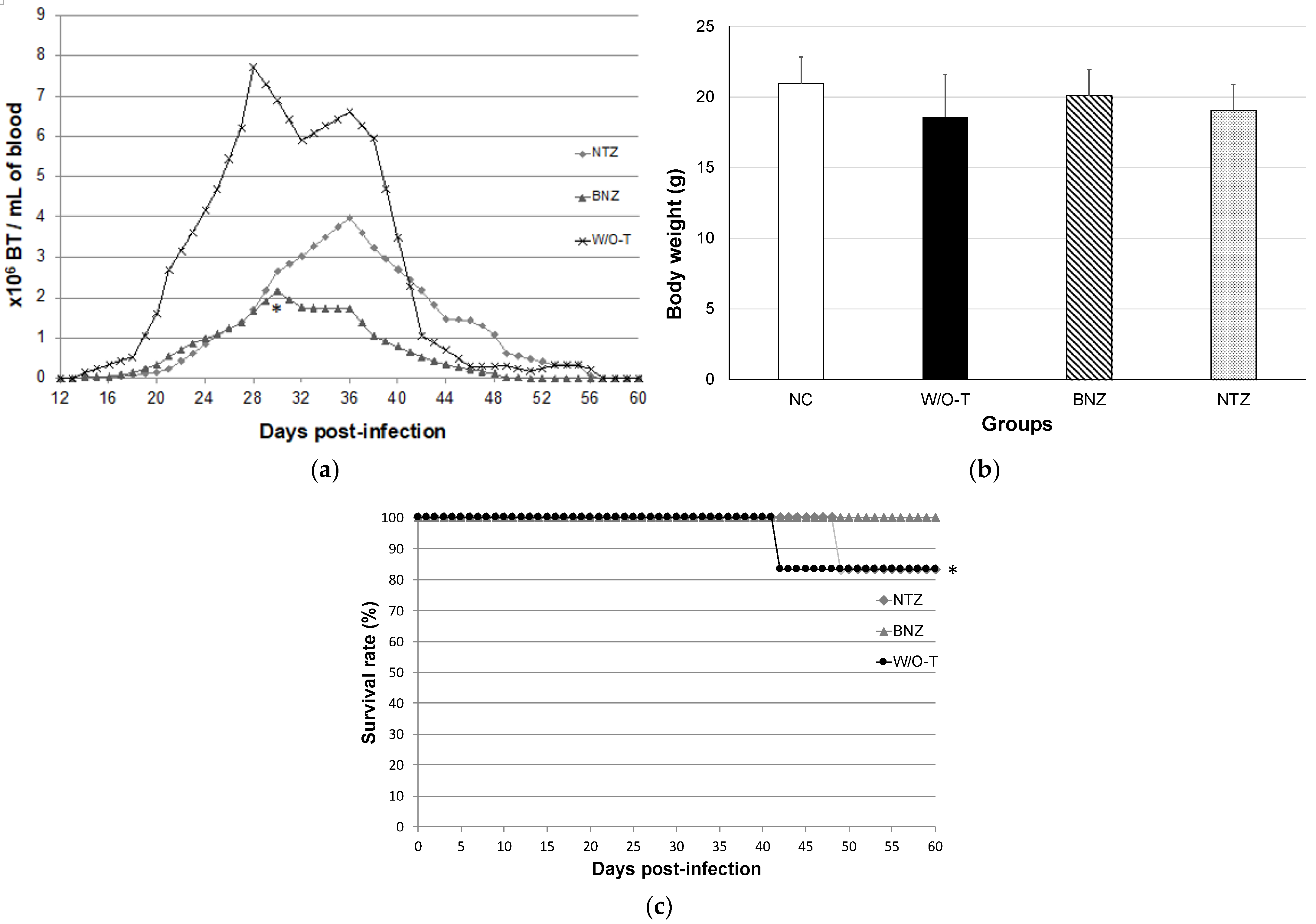
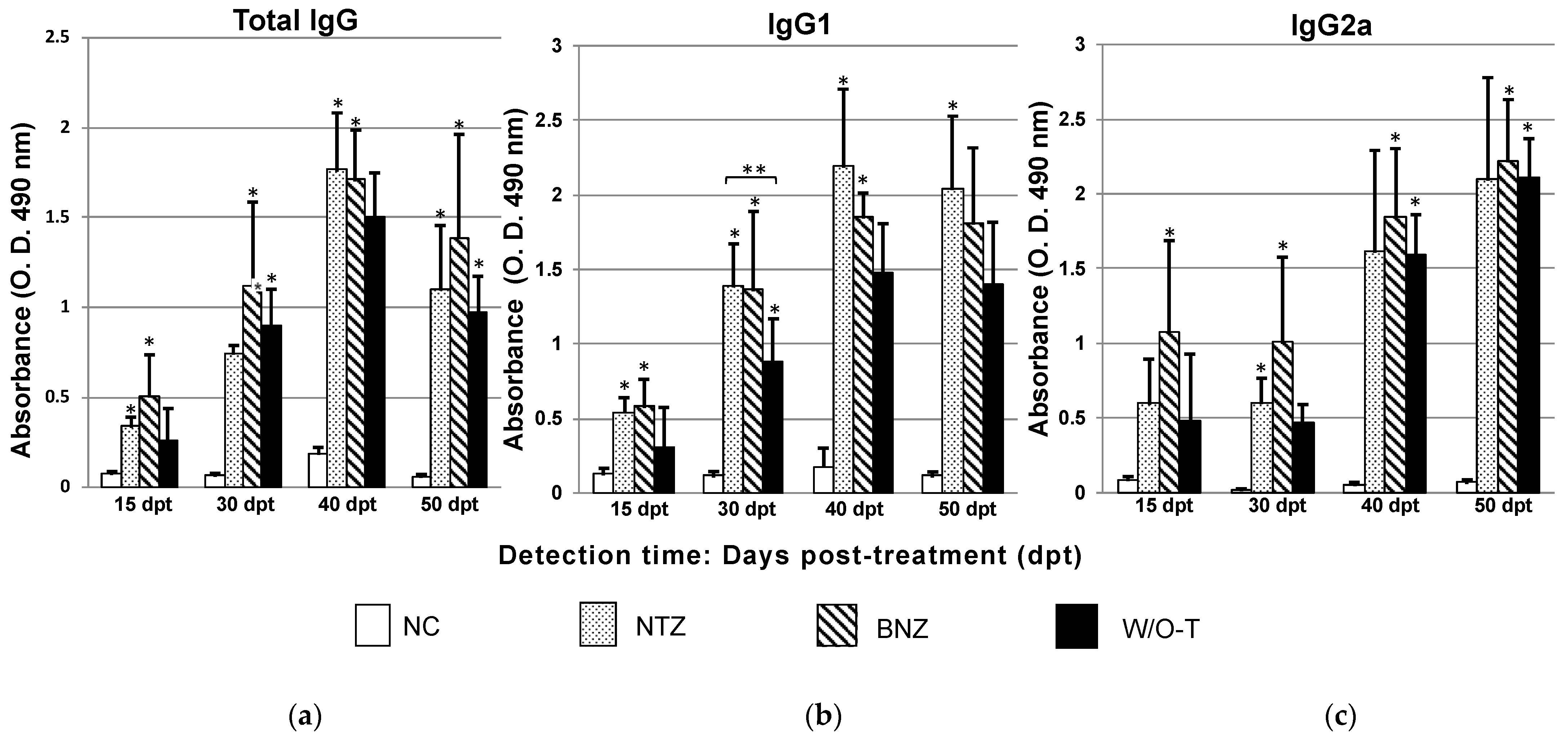

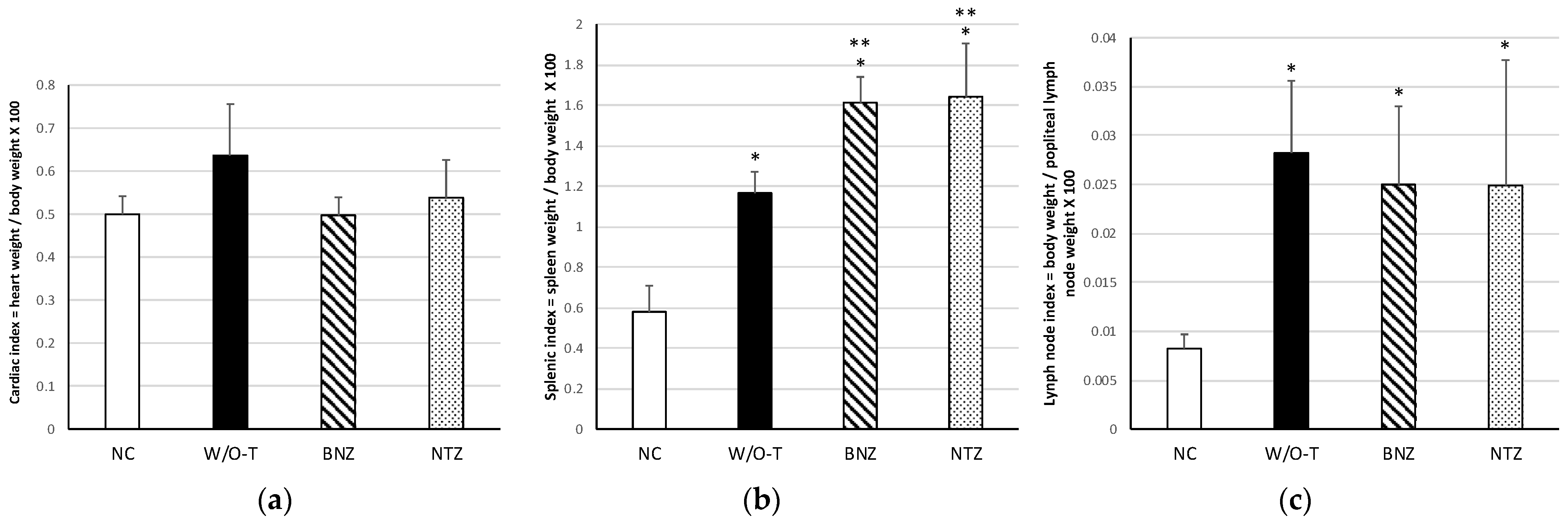
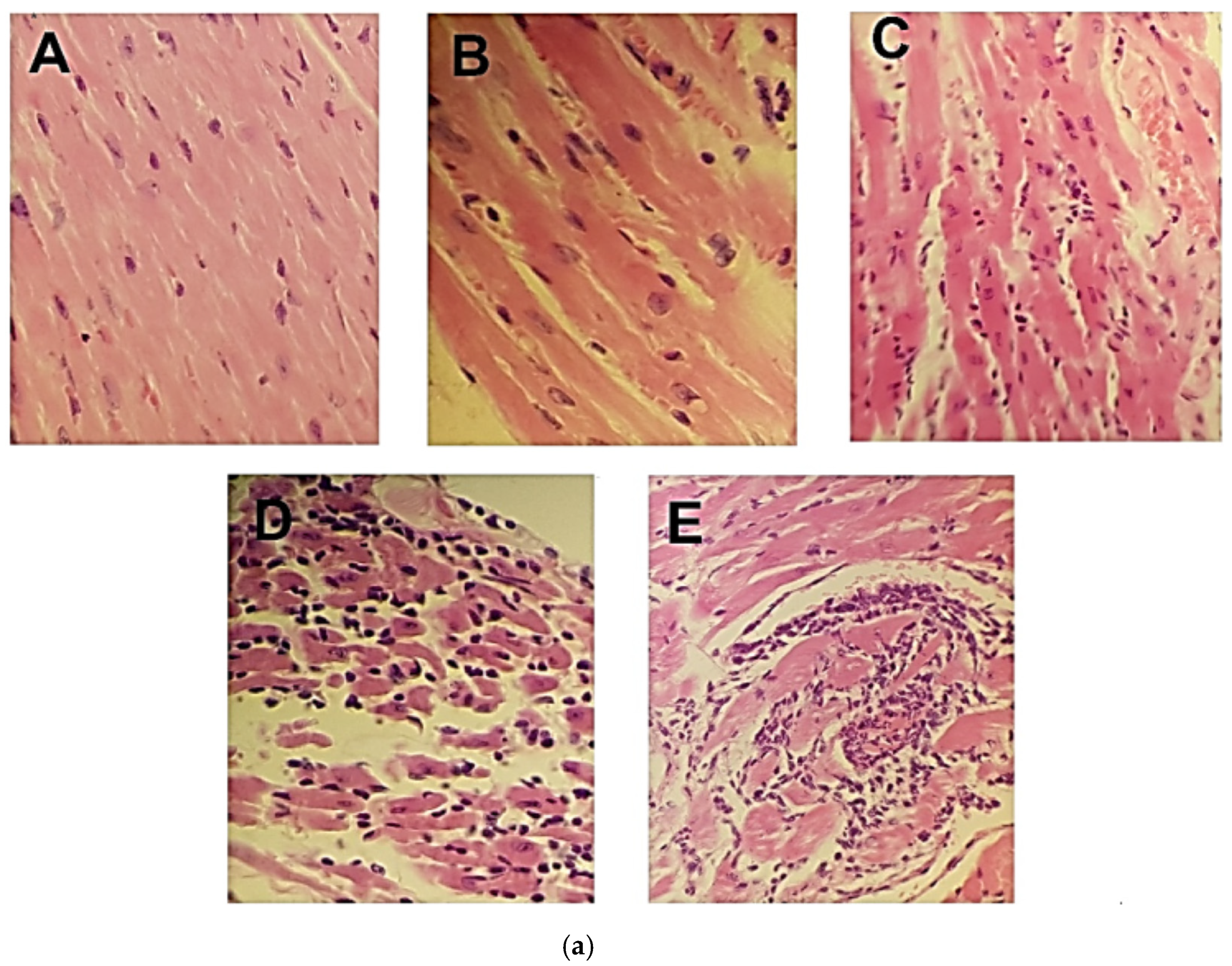
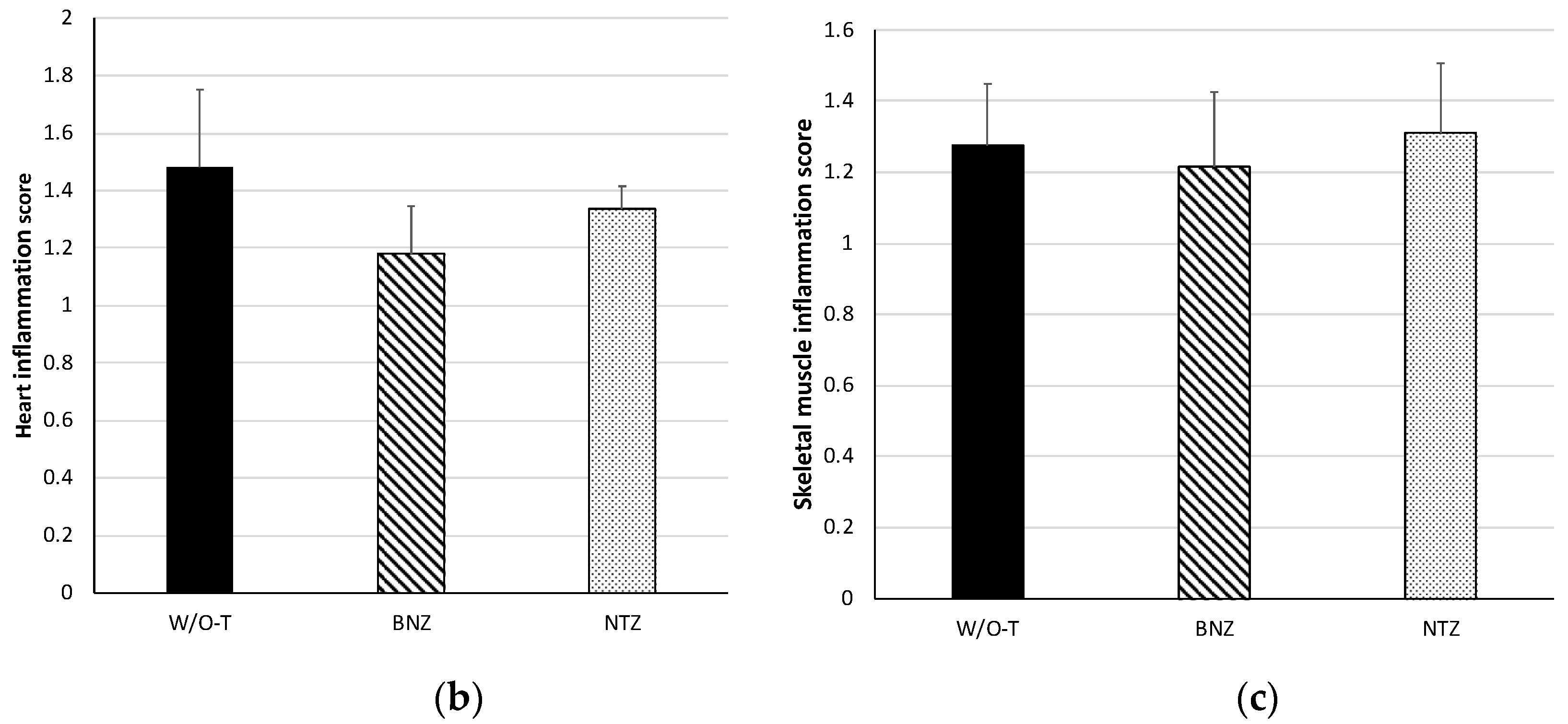
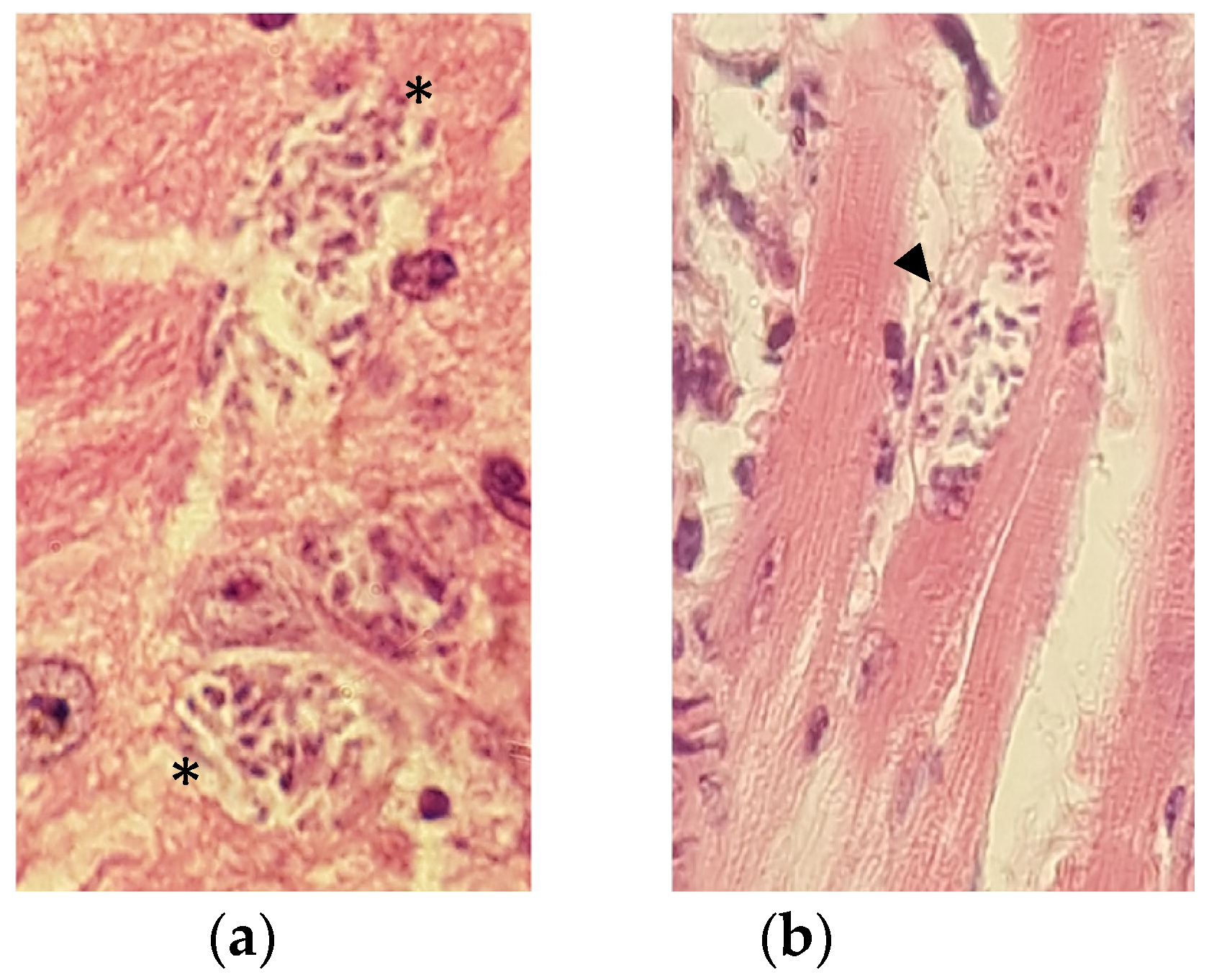
Disclaimer/Publisher’s Note: The statements, opinions and data contained in all publications are solely those of the individual author(s) and contributor(s) and not of MDPI and/or the editor(s). MDPI and/or the editor(s) disclaim responsibility for any injury to people or property resulting from any ideas, methods, instructions or products referred to in the content. |
© 2023 by the authors. Licensee MDPI, Basel, Switzerland. This article is an open access article distributed under the terms and conditions of the Creative Commons Attribution (CC BY) license (https://creativecommons.org/licenses/by/4.0/).
Share and Cite
Arce-Fonseca, M.; Gutiérrez-Ocejo, R.A.; Rosales-Encina, J.L.; Aranda-Fraustro, A.; Cabrera-Mata, J.J.; Rodríguez-Morales, O. Nitazoxanide: A Drug Repositioning Compound with Potential Use in Chagas Disease in a Murine Model. Pharmaceuticals 2023, 16, 826. https://doi.org/10.3390/ph16060826
Arce-Fonseca M, Gutiérrez-Ocejo RA, Rosales-Encina JL, Aranda-Fraustro A, Cabrera-Mata JJ, Rodríguez-Morales O. Nitazoxanide: A Drug Repositioning Compound with Potential Use in Chagas Disease in a Murine Model. Pharmaceuticals. 2023; 16(6):826. https://doi.org/10.3390/ph16060826
Chicago/Turabian StyleArce-Fonseca, Minerva, Rodolfo Andrés Gutiérrez-Ocejo, José Luis Rosales-Encina, Alberto Aranda-Fraustro, Juan José Cabrera-Mata, and Olivia Rodríguez-Morales. 2023. "Nitazoxanide: A Drug Repositioning Compound with Potential Use in Chagas Disease in a Murine Model" Pharmaceuticals 16, no. 6: 826. https://doi.org/10.3390/ph16060826
APA StyleArce-Fonseca, M., Gutiérrez-Ocejo, R. A., Rosales-Encina, J. L., Aranda-Fraustro, A., Cabrera-Mata, J. J., & Rodríguez-Morales, O. (2023). Nitazoxanide: A Drug Repositioning Compound with Potential Use in Chagas Disease in a Murine Model. Pharmaceuticals, 16(6), 826. https://doi.org/10.3390/ph16060826






